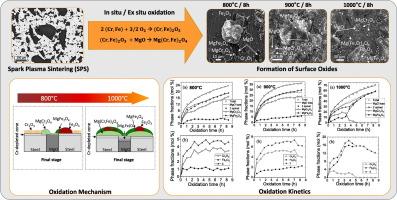Spinel coatings produced via oxidation of an AISI 316L-MgO composite
IF 6.1
2区 材料科学
Q1 MATERIALS SCIENCE, COATINGS & FILMS
引用次数: 0
Abstract
The possibilities of producing protective spinel coatings on the surface of an AISI 316L-MgO composite via high-temperature oxidation at 800 °C, 900 °C and 1000 °C were explored using a combination of structure and microstructure analyses, and thermodynamic calculations. The structure and microstructure of the coatings were analyzed in situ and ex situ using high-temperature and conventional X-ray diffraction, scanning electron microscopy, electron backscatter diffraction and X-ray spectroscopy. The ex situ analyses identified the oxidation and reaction products and revealed their spatial distribution within the surface coating. The in situ analyses helped to describe the oxidation and reaction kinetics. It was found that Cr2O3, which forms on the surface of oxidized austenite grains, reacts quickly to the MgCr2O4 spinel, when it comes in contact with MgO. Longer oxidation times and higher oxidation temperatures facilitate the formation of Fe2O3 and MgFe2O4, which partially intermix with Cr2O3 and MgCr2O4. As the spinel phases are formed via interdiffusion and as their molar volume is larger than the molar volume of the original phases (MgO, Cr2O3/Fe2O3), they overgrow the surface of the MgO grains. This mechanism provides a basis for controlled growth of protective spinel coatings on the surface of the AISI 316L-MgO composites.

通过aisi316l - mgo复合材料氧化制备尖晶石涂层
采用结构、微观结构分析和热力学计算相结合的方法,探索了在800℃、900℃和1000℃的高温氧化条件下,在AISI 316L-MgO复合材料表面制备尖晶石防护涂层的可能性。利用高温和常规x射线衍射、扫描电镜、电子背散射衍射和x射线能谱分析了涂层的原位和非原位结构和微观结构。非原位分析鉴定了氧化产物和反应产物,并揭示了它们在表面涂层中的空间分布。原位分析有助于描述氧化和反应动力学。结果表明,氧化奥氏体晶粒表面生成的Cr2O3与MgO接触后,与MgCr2O4尖晶石反应迅速。较长的氧化时间和较高的氧化温度有利于Fe2O3和MgFe2O4的形成,并与Cr2O3和MgCr2O4部分混合。由于尖晶石相是通过相互扩散形成的,其摩尔体积大于原始相(MgO、Cr2O3/Fe2O3)的摩尔体积,因此尖晶石相在MgO晶粒表面过度生长。该机理为AISI 316L-MgO复合材料表面尖晶石保护性涂层的可控生长提供了基础。
本文章由计算机程序翻译,如有差异,请以英文原文为准。
求助全文
约1分钟内获得全文
求助全文
来源期刊

Surface & Coatings Technology
工程技术-材料科学:膜
CiteScore
10.00
自引率
11.10%
发文量
921
审稿时长
19 days
期刊介绍:
Surface and Coatings Technology is an international archival journal publishing scientific papers on significant developments in surface and interface engineering to modify and improve the surface properties of materials for protection in demanding contact conditions or aggressive environments, or for enhanced functional performance. Contributions range from original scientific articles concerned with fundamental and applied aspects of research or direct applications of metallic, inorganic, organic and composite coatings, to invited reviews of current technology in specific areas. Papers submitted to this journal are expected to be in line with the following aspects in processes, and properties/performance:
A. Processes: Physical and chemical vapour deposition techniques, thermal and plasma spraying, surface modification by directed energy techniques such as ion, electron and laser beams, thermo-chemical treatment, wet chemical and electrochemical processes such as plating, sol-gel coating, anodization, plasma electrolytic oxidation, etc., but excluding painting.
B. Properties/performance: friction performance, wear resistance (e.g., abrasion, erosion, fretting, etc), corrosion and oxidation resistance, thermal protection, diffusion resistance, hydrophilicity/hydrophobicity, and properties relevant to smart materials behaviour and enhanced multifunctional performance for environmental, energy and medical applications, but excluding device aspects.
 求助内容:
求助内容: 应助结果提醒方式:
应助结果提醒方式:


